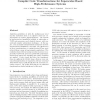Free Online Productivity Tools
i2Speak
i2Symbol
i2OCR
iTex2Img
iWeb2Print
iWeb2Shot
i2Type
iPdf2Split
iPdf2Merge
i2Bopomofo
i2Arabic
i2Style
i2Image
i2PDF
iLatex2Rtf
Sci2ools
SC
1992
ACM
1992
ACM
Compiler Code Transformations for Superscalar-Based High Performance Systems
Exploiting parallelism at both the multiprocessor level and the instruction level is an e ective means for supercomputers to achieve high-performance. The amount of instruction-level parallelism available to superscalar or VLIW node processors can be limited, however, with conventional compiler optimization techniques. In this paper, a set of compiler transformations designed to increase instruction-level parallelism is described. The e ectiveness of these transformations is evaluated using 40 loop nests extracted from a range of supercomputer applications. This evaluation shows that increasing execution resources in superscalar VLIW node processors yields little performance improvement unless loop unrolling and register renaming are applied. It also reveals that these two transformations are su cient for DOALL loops. However, more advanced transformations are required in order for serial and DOACROSS loops to fully bene t from the increased execution resources. The results show that ...
Applied Computing | Compiler Transformations | Instruction-level Parallelism | SC 1992 | VLIW Node Processors |
| Added | 10 Aug 2010 |
| Updated | 10 Aug 2010 |
| Type | Conference |
| Year | 1992 |
| Where | SC |
| Authors | Scott A. Mahlke, William Y. Chen, John C. Gyllenhaal, Wen-mei W. Hwu |
Comments (0)

